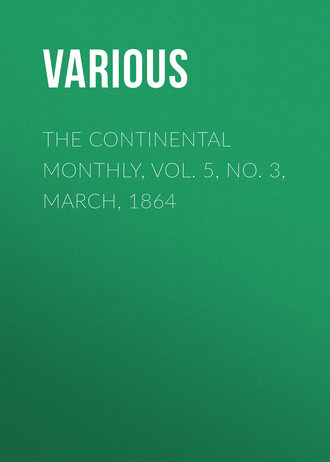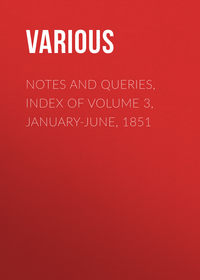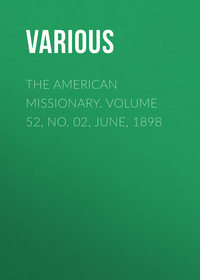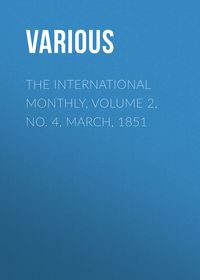 полная версия
полная версияThe Continental Monthly, Vol. 5, No. 3, March, 1864
For seventy years we have had these Census Tables, announcing these great truths more and more clearly at each decade. They are the records of the nation's movement and condition, the decennial monuments marking her steps in the path of empire, the oracles of her destiny. They are prophecies, for each decade fulfils the predictions of its predecessor. They announce laws, not made by man, but the irrevocable ordinances of the Almighty. We cannot, with impunity, refuse to obey these laws. For every violation, they enforce their own penalties. From these there is no escape in the present or the past, nor for the future, except in conformity to their demands. These laws condemn slavery; and the punishment for disobedience is recorded in the result of every Census, and finally culminated in the rebellion. Slavery and freedom are antagonistic and discordant elements: the conflict between them is upon us; it admits of no neutrality or compromise, and one or the other system must perish.
We have seen that slavery is hostile to the progress of wealth and population: let us now ascertain its influence on moral and intellectual development.
By Table 15 of the Census of 1860, the result for that year was as follows: In Massachusetts, value of books printed, $397,500; jobs, $529,347; newspapers, $1,979,069; total, $2,905,916. Same year in Maryland, books printed, $58,000; jobs, $122,000; newspapers, $169,000; total, $350,155. By Table 37, Census of 1860, Massachusetts had 222 newspapers and periodicals, of which 112 were political, 31 religious, 51 literary, miscellaneous 28. Maryland had only 57, all political. The whole number of copies issued in Massachusetts in 1860 was 102,000,760, and in Maryland, 20,721,472. Of periodicals, Massachusetts has monthly, 1 political, 10 religious, 18 literary, 7 miscellaneous; quarterly, religious 3, literary 2, miscellaneous 1, and 1 annual. Maryland had none. Not a religious, literary, scientific, or miscellaneous periodical or journal in the State! What terrible truths are unfolded in these statistics! None but a political party press in Maryland, all devoted, in 1860, to the maintenance, extension, and perpetuity of slavery, which had 57 advocates, and not one for science, religion, or literature.
We have seen that the circulation in 1860 of the press in Massachusetts exceeded that of Maryland by more than eighty-one millions of copies. These facts all prove that slavery is hostile to knowledge and its diffusion, to science, literature, and religion, to the press, and to free government.
For schools, colleges, libraries, and churches, I must take the Tables of the Census of 1850, those of 1860 not being yet published. There were in 1850 in Massachusetts, 3,679 public schools, 4,443 teachers, 176,475 pupils; native adults who cannot read or write, 1,861. In Maryland, 907 public schools, 1,005 teachers, 33,254 pupils; native adults who cannot read or write, 38,426, excluding slaves, to teach whom is criminal.
Thus, then, slavery is hostile to schools, withholding instruction from the children of the poor.
The number of public libraries in Massachusetts was 1,462, volumes 684,015. In Maryland, 124, and 125,042 volumes. Value of churches in Massachusetts, $10,206,000. In Maryland, $3,947,884, of which $2,541,240 is in Baltimore (which has very few slaves), and the remainder is mainly in the seven counties (from which slavery has nearly disappeared) adjoining Pennsylvania.
As to schools, colleges, books, libraries, churches, newspapers, and periodicals, it thus appears that Massachusetts is greatly in advance of Maryland.
Now, then, let us contrast loyal Maryland with rebel South Carolina, the author of secession, and assuming for many years to instruct the nation. By the Census of 1860, she had a population of 703,708, of whom 402,406 were slaves; and Maryland, numbering 687,049, had 87,189 slaves. Now, by the Census of 1860, South Carolina had 45 journals and periodicals, and her annual circulation was 3,654,840 copies. The circulation therefore of Massachusetts exceeded that of South Carolina more than ninety-eight millions of copies, while Maryland exceeded South Carolina more than seventeen millions of copies. So much for South Carolina as a great political teacher. As to schools in 1850: South Carolina had 724 public schools, 739 teachers, 17,838 pupils. Massachusetts, then, had 158,637 more pupils at public schools than South Carolina, and Maryland 15,416 more pupils at public schools than South Carolina.
The press of Massachusetts, we have seen, circulated in 1860 upward of one hundred and two millions of copies, equal to 279,454 per day, including journals and periodicals, each read, on an average, by at least two persons. This is independent of books and pamphlets, and of the very large circulation of papers from other States and from Europe. What a flood of light is thus shed daily and hourly upon the people of Massachusetts! This intellectual effulgence radiates by day and night. It is the sun in its meridian splendor, and the stars in an ever-unclouded firmament. It has a centre and a circumference, but no darkness. Ignorance vanishes before it; wealth follows in its train; labor rejoices in its association, and finds its products more than doubled; freedom hails its presence, and religion gives it a cordial welcome; churches, schools, academies, colleges, and universities acknowledge its mighty influence. Science penetrates the secrets of nature, and unfolds each new discovery for the benefit of man. Coal, the offspring of the sun, develops its latent energy, and water contributes its untiring hydraulic power. Machinery takes more and more the place of nerves and muscles, cheapens clothing and subsistence and all the necessaries of life, and opens new fields of industry, and more profitable employment for labor. Steam and lightning become the slaves of man. He performs the journey of a day in an hour, and converses in minutes around the globe. The strength of man may not have been much increased, but his power is augmented a thousand fold.
His life may not have been materially lengthened, but, in the march of knowledge, a year now is as a century, compared with man's progress in the darkness of the middle ages. The eternal advance toward omniscience goes on, but is like that of the infinite approach of the asymptote, which never reaches the hyperbolic curve. The onward of science is in a geometrical ratio, so that in time, the intellectual progress of a day in the future, must exceed that of a century in the past. Knowledge is enthroned as king, and grand truths and new ideas are his ministers. Science takes the diameter of the earth's orbit as a base line and unit of measurement, and with it spans immensity, and triangulates the nebulous systems amid the shadowy verges of receding space. Its researches are cosmical upon the earth and the heavens, and all the elements minister to its progress. Sink to the lowest mine, or fathom the ocean's depth, or climb the loftiest mountains, or career through the heavens on silken wings, and it is there also. On—on—on; nearer—nearer—still nearer it moves forever and forever, with accelerated speed, toward the infinite eternal. Such are the triumphs of knowledge; and he who diffuses it among our race, or discovers and disseminates new truths, advances man nearer to his Creator; he exalts the whole race; he elevates it in the scale of being, and raises it into higher and still higher spheres.
It is science that marks the speed of sound and light and lightning, calculates the eclipses, catalogues the stars, maps the heavens, and follows, for centuries of the past and the future, the comet's course. It explores the animal, vegetable, and mineral kingdoms. With geology, it notes the earthquake upheaval of mountains, and, with mineralogy, the laws of crystallization. With chemistry, it analyzes, decomposes, and compounds the elements. If, like Canute, it cannot arrest the tidal wave, it is subjecting it to laws and formulas. Taking the sunbeam for its pencil, it heliographs man's own image, and the scenery of the earth and the heavens. Has science any limits or horizon? Can it ever penetrate the soul of man, and reveal the mystery of his existence and destiny? It is certainly exploring the facts of sociology, arranging and generalizing them, and deducing laws.
Man, elevated by knowledge in the scale of being, controls the forces of nature with greater power and grander results, and accumulates wealth more rapidly. The educated free labor of Massachusetts, we have seen, doubles the products of toil, per capita, as compared with Maryland, and quadruples them (as the Census shows) compared with South Carolina. One day's labor of a man in Massachusetts is more than equal to two in Maryland, and four in South Carolina. So, if we take our savage tribes, with their huts and tents, their rude agriculture, their furs, their few and simple household manufactures, their hunting and fishing, the average product of their annual labor, at four cents a day each, would be $14.60 a year, or more than a fourth of that of South Carolina (56.91). So that Massachusetts, in material progress, is farther in advance of South Carolina than that State is of the savage Indians. Thus we have the successive steps and gradations of man: Massachusetts, with free labor and free schools, having reached the highest point of civilization: South Carolina, with slavery and ignorance (except the few), in a semi-barbarous stage; and the lowest savage condition, called barbarous, but nearer to South Carolina than that State to Massachusetts.
Slavery, then, the Census proves, is hostile to the progress of wealth and population, to science, literature, and education, to schools, colleges, and universities, to books and libraries, to churches and religion, to the press, and therefore to free government; hostile to the poor, keeping them in want and ignorance; hostile to labor, reducing it to servitude, and decreasing two thirds the value of its products; hostile to morals, repudiating among slaves the marital and parental condition, classifying them by law as chattels, darkening the immortal soul, and making it a crime to teach millions of human beings to read or write. And shall labor and education, literature and science, religion and the press, sustain an institution which is their deadly foe?
The discussion will be continued in my next letter. R. J. Walker.
PALMER, THE AMERICAN SCULPTOR
Sculpture as an art is probably anterior to painting. Form being a simpler quality than color, the means of imitation were found in a conformity of shape rather than hue. The origin of sculpture is somewhat obscured in the thickening mists of antiquity, but it was no doubt one of the earliest symbols of ideas made use of by man. In fact, in its primitive development, there is considerable evidence to show that it was the first essay at a recorded language. The Egyptian hieroglyphics, those mysterious etchings upon the rock, representing animals, men, and nondescript characters, were unquestionably rude attempts to hand down to posterity some account of the great events of those forgotten ages. The next remove in the history of this art is its employment in the production of the images of idolatrous worship; and, when confined to this purpose, it never attained any appreciable excellence. The purely heathen mind was incapable of conceiving those forms of ideal beauty which are born of the contemplation of a divine and spiritual beauty revealed in the word of God and the teachings of his immaculate Son.
The grotesque Egyptian images worshipped on the Nile before the building of the pyramids, are, judging from the best preserved antiquities, not very much inferior to the gilded deities to be seen to-day in the thousand pagodas of heathen lands.
Take for example a Chinese idol of modern make: while it is less angular and more elaborately finished than the ancient monstrosities found in Egypt, still, so far as perfection of form or beauty of expression is concerned, there is little to choose between the two. Each is a fitting type of the degree of civilization and soul culture of the peoples that produced them. It must not be urged that the success of sculpture in Greece and Rome disproves the proposition that the art could not develop itself among a strictly idolatrous race.
The splendid mythologies of the Greeks and Romans must not be considered as the highest forms even of the worship of idols or inanimate things. The gods and goddesses of these mythological systems were principally the powers that were supposed to preside over the different forces and elements of nature, and were invested with the celestial attributes of a higher order of beings. Neptune ruled the sea, Pluto was director of ceremonies in the infernal regions, while Jupiter was emperor of the sky and king of all the lesser gods.
These deities were the invention of a cultivated intellect, a refined taste and polished civilization, and furnish a striking proof of man's longing after the Infinite, unguided by the star of revelation.
The imaginative Greeks did not worship the statues of the gods per se, but only admired them as the fitting representations of those mysterious forces that hold sway over earth, air, fire, and water, or reverenced them as the symbols of noble sentiments or sublime passions. The thing itself, the cunning but lifeless figure, was only incidental, while the idea thus typified was the real incentive to worship. This was also the age that produced hero worship, and the great man who won the praise and admiration of the people by his exalted qualities, or his prowess in arms, was considered as a demigod, or one in favor with the tenants of Olympus, and his statue was accordingly erected, to stand beside that, perhaps, of Mars, Apollo, or Mercury.
Thus we trace the history of sculpture in its steady progress from its use as a chronicler of events to its employment in the production of the objects of idolatry, and thence to the mythological period, when it became the medium of æsthetic expression, attaining its highest perfection in the palmy days of Greece.
In no people of which the records of the past give any account, can we find such an active sense of the beautiful as that which permeated the minds of the polished Greeks. The admiration of physical beauty became an almost absorbing passion, and its attainment was sought after in every process which human ingenuity could devise.
The Lacedemonian women were accustomed to place the statues of beautiful gods or goddesses in their rooms, to the end that the children they should give birth to, would, by nature's mysterious methods, assimilate the artistic graces of these celestial models. Perfection of form and manly strength were the pride of the wisest and most learned men of the nation, denoting that physical excellence was considered the necessary concomitant of moral or intellectual worth. Authentic annals tell us that Plato and Pythagoras appeared as wrestlers at the public games; and who shall say that these philosophical gymnasts did not derive much of their mental vigor from this exciting exercise? In this age it is easy to see that sculpture must have received every incentive to full development. In the people about him the artist saw the most excellent models for his chisel, while the national taste was educated to the highest degree in the beauties of form and the harmonies of proportion.
But the grand conceptions of Phidias, full of majesty and of grandeur as they are—the matchless finish of the works of Apelles and Praxiteles, ravishing the senses with their carnal beauty, still lacked one element, without which art can never reveal itself in the full perfection of its latent capabilities.
Mere physical beauty, which contains no spiritual element, no drawing of the immortal soul, no suggestion of purer and nobler sentiments struggling for expression in the cunning marble, can never satisfy the requirements of the Christianized taste of modern times.
The Venus de Medici was undoubtedly the ideal type of womanly perfection in the age which produced it, but now the sex would hardly feel themselves flattered by so poor an interpretation. The form is all that could be desired, but the head and features are positively insipid, and a phrenologist would tell you by the development of the cranium that female education was not a part of the Grecian policy. There is in this statue a certain air of wantonness, a perceptible consciousness of being valued and admired solely for physical beauty, which just as plainly tells the estimate placed upon woman in those times as we can read the fact in history.
Thus we perceive sculpture as a representative art has become a chronicler of the world's advancement, so that those who accept the theory of human progression would naturally look for purer and more spiritual conceptions in the artist's soul, with a corresponding nobility in the creations of his genius. The æsthetic principle in its higher manifestations is not the product of pagan mind, because ideal beauty and the rules governing its expression can only be conceived by him to whom Faith has opened the glorious possibilities of our existence beyond the grave. In no classic picture or statue is there anything akin to that divine affinity that is apparent in the Madonnas of the Italian masters of the sixteenth century, investing them with a charm that lingers like an autumn sunset In the recollection of long-departed years. Compare the loveliest of the Madonnas of Correggio and Raphael with the Venus of Cos, and we perceive the inferiority of mere physical perfection to that spiritual beauty that exalts the soul of the beholder, and awakens the slumber of his immortal longings.
Faultless finish, harmonious outlines, and voluptuous proportions are only the result of mechanical skill, that a good imitator or copyist can for the most part achieve by the aid of his master's model. But the sentiment, emotion, passion, the character, so to speak, of the statue, is the creation of the artist, the offspring of his quickened brain.
It is to express the æsthetic idea struggling in the soul of genius, that the marble takes its form, the canvas its color, sweet sounds combine in melody, and language weaves itself into the wreath of song. The same divine impulse, the same grasping after a higher excellence inspires the sculptor, the painter, the composer, and the poet, but some chance bent of nature has decided them to choose different mediums of expression.
Some critic has written, had Coles' 'Voyage of Life' been executed in verse, instead of a series of pictures, it would have ranked as one of the grandest poems of the age. High art, then, whatever its kind, is the language of the æsthetic feeling in man—it symbolizes the god-like element in his nature. Cumulative and progressive, it keeps even pace with an improving civilization, and should therefore furnish fairer products to-day than in any period of the past. It assimilates the spirit of the times in which it is exercised; for as Ralph Waldo Emerson remarks in his subtle, essay: 'No man can quite emancipate himself from his age and country, or produce a model in which the education, the religion, the politics, usages, and arts of his times shall have no share.'
So we see from the very necessity of this truism, that if our painters and sculptors would not be mere imitators of the exponents of another age, there would be soon established a national school of art. We do not mean by this a mere conventional type in finish and mode of treatment, but certain marked, characteristic excellences and features that would identify it with the history of our country and the peculiarities of our people. There are a few native artists who have struggled to achieve this consummation, and preëminent among these is Erastus D. Palmer, the American sculptor.
The history of his career, his origin, his process of study, his choice of subjects in all his great works, his rise and triumph as an artist, all entitle him to this distinctive appellation. He commenced life as a carpenter and joiner, but, while practising his trade in Utica, N. Y., his eye accidentally fell on a cameo likeness, and as the dropping of an apple suggested to Newton the laws of gravitation, so the sight of this little trifle was the talisman that revealed to Palmer the artistic capabilities of his genius. Being thus led to attempt the portrait of his wife upon a shell, he executed his task—which was in a twofold sense a labor of love—with such fidelity to nature, such bold outline, and delicacy of finish, that connoisseurs detected in it the hand of a master. Thus encouraged, he for two years made cameo cutting his business, and followed it with remarkable success, till, his eyes becoming affected by the exercise of this talent, he was obliged to relinquish it, with the expectation of returning to his old trade. But happily he was induced to try his skill at modelling in clay, and then he discovered what was in him. Taking his little girl for a model, he produced a bust, styled the 'Infant Ceres,' which, when finished in marble, immediately took rank as one of the gems of art. The sweet naïvete of budding childhood, the timid eyes and dimpled cheek, all refined and sublimated by the ideal graces added by the magic wand of genius, combined to make this earliest bust of our sculptor one of the most felicitous products of his chisel.
Soon after this satisfactory experiment, Palmer removed to the city of Albany, where he has since remained and won his well-deserved fame. His two allegorical pieces, 'Resignation' and 'Spring,' we cannot forbear to describe, familiar as they are to the virtuoso of art, and well known even to the great public.
The latter is a female bust, her hair bound with a fillet of grass and half-developed grain, her face wearing an expression of modest coquetry, quite in keeping with the capricious, 'celestial maid;' while the gently swelling bosom suggests the latent forces of nature which only reach their fulness in the summer sun. And about the eyes there is a look of joy and freshness in which you fancy you can see
'the flowers begin to spring,The skies to brighten, and the birds to sing.'The 'Resignation' represents the refined voluptuousness of riper womanhood. The features are exquisitely cut, and represent a type of beauty fit for angelic spheres. The head, so finely proportioned, and crowned with luxuriant, waving hair, inclines gracefully to one side, as in submission to the chastenings of Providence. But in the downcast, sorrowful eyes, there is an expression of mingled hope and patient endurance such as Mary might have worn at the foot of the cross. The marble is eloquent of that Christian sentiment: 'He doeth all things well.' The religious feeling of the sixteenth century, which gave to art both its inspiration and theme, never found so fair a mould as in this bust of 'Resignation.'
Both of these works are entirely free from all explanatory accessories, and interpret themselves to the most sluggish soul.
Another of Palmer's compositions, and one of the most purely ideal, is the 'Dream of the Spirit's Flight.' This is a large bas-relief, executed in medallion style. To give any idea by mere words of the spirit of this performance is impossible. It is the half figure of a peri-like girl, with tresses swaying in the higher air, with butterfly wings, arms and drapery gracefully disposed, and all the parts uniting to impress you with a sense of upward, soaring motion! There is a divine beauty about the face reflected from a brighter world. Sculptured in pure white marble, it seems a very soul just escaped from its prison house of clay, and, listening to those 'sounds seraphic,' bearing away to the great Beyond.
While gazing on this airy sprite, the beholder feels an exhilarating influence steal over him, and involuntarily there goes up from his heart, like incense, that yearning prayer:
'So grant me, God, from every care,And stain of passion free,Aloft through virtue's purer airTo hold my course to Thee!'We cannot speak separately of his 'Morning and Evening,' 'Immortality,' 'Sleeping Peri,' his statue and bas-relief of 'Faith,' busts, and other works, which are grouped in odd companionship about his studio. But the 'Indian Girl' and 'White Captive,' the crowning achievements of Palmer's genius, and the ones that give a thoroughly American character to his reputation, demand an elaborate consideration—not to explain their merits, but to show what materials for art exist in our history, when appropriated by the master's hand.









